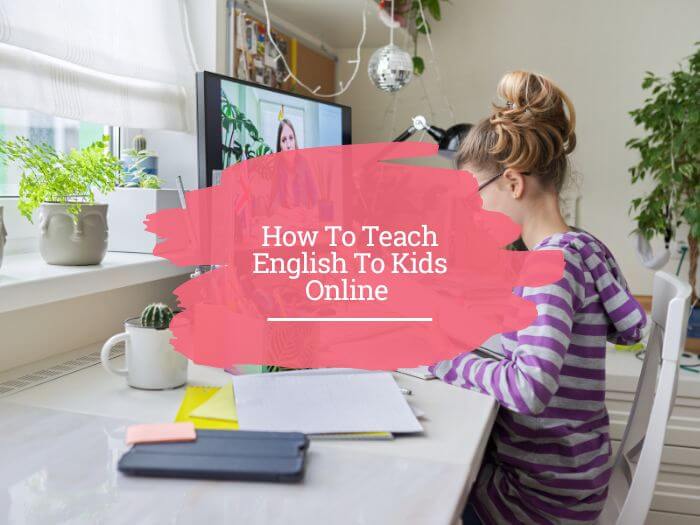So you’re interested in teaching English to kids online. For a few years, teaching online mostly meant teaching English to kids online with the rise of companies like VIP Kid, GoGoKid or Palfish.
Since the Chinese government changed the rules on tutoring for Chinese school children, the industry is not what it used to be.
That said, parents will always be interested in helping their kids get ahead in a globalised world thanks to English classes, whether online or offline. So there are still plenty of opportunities out there to teach English to children online.
In this article, you’ll learn about what teaching kids online requires, where to look for jobs, how much you can expect to earn as well as tips for creating fun and engaging online classes for children.
Pro Tip
If you want to become a qualified online language teacher and earn a living from home, I recommend checking out CeOLT (Certificate of Online Language Teaching).
Why Teach Kids Rather Than Adults

Well, if you’re reading this then you’re probably interested in teaching English to kids online. But, you may want to teach ESL to children because you’ve already had experience working with them and enjoyed it and want to pivot to language teaching.
Perhaps you’ve been a summer camp counsellor or have worked in an after school club. Maybe you even have experience teaching children in your country as a K-12 teacher or nursery or primary school teacher.
As I mentioned before, for a while, a big chunk of the online ESL teaching market was about teaching kids, mostly Chinese ones. So teaching kids, particularly for Chinese companies, was a good move for many people as it paid well for the sector and was in high demand.
Other than money and opportunities, which are thinner on the ground than they used to be, you may want to teach kids because it’s fun. Teaching kids requires a slightly different skill set to teaching adults as we’ll see in the next section.
If you’d like to do fun class activities, have a natural entertainer or creative side or want to teach in a different way, using mostly songs, games and props, then teaching kids could suit you. More on that in the next section.
How Does Teaching Kids Differ From Teaching Adults?
So you may be aware of the truism that kids pick up languages faster than adults. The reality is not quite that simple. But it’s true that kids tend to be less inhibited than adults and not so self-conscious about using a new language.
They don’t tend to worry so much about mistakes. And in fact, they might not actually take corrections on board.
Their ability to try out new things like speaking a language, without the hang-ups of adults, means they can seem to progress more quickly. And they can certainly pick up a lot if they’re in a total immersion environment.
Advantages That Adults Have Over Kids

That said, adults do have some advantages when it comes to language learning. While many adults let mindset issues get in the way of starting to speak, they're able to do the metacognitive work of thinking about and planning their language learning.
They know how they prefer to learn and can reflect on their learning, choosing to continue working with material or discard it if it’s not useful.
Children, especially younger ones, haven’t yet developed these cognitive skills. So you won’t be able to take advantage of them. Instead you’ll have to jump straight into activities and games to make them use English.
Another issue is that children may not be able to read and write yet in their own language. While excessive note-taking can also inhibit adults in their language learning, it means that they can get input from reading as well as listening.
Young children can only pick up the language orally which limits the richness and variety of what they’re exposed to. One of the reasons you learn through reading here at StoryLearning® is that you get exposure to “better quality” language than you do when just listening to a language.
That said, if the kids you’re working with are old enough, it can be interesting to use a phonics approach to start teaching them the sounds of English and the sound-spelling correspondences so they can start doing some reading and writing too.
Concentration And Energy Levels

Another big difference between children and adults are concentration and energy levels. Of course, even with adults you need to plan for activities of different lengths. No-one is going to enjoy 60 minutes with their head in grammar exercises!
But while adults can concentrate for longer periods and work more autonomously, kids need a lot of variety.
When I first started teaching kids, the school owner told me that I would need to change activities every five minutes! Typically, lessons with kids, especially online, will be shorter to reflect their inability to concentrate for long periods of time.
Kids also benefit from being able to move around often, especially if they’re young. This can be a little harder to incorporate into online teaching but it is still possible. Keep reading to find out how.
And finally, while adults can enjoy using games and songs when learning English, kids love them even more. In fact, you’ll mostly use materials like this plus props and movement to teach children.
While you can get them to sit at their desks and do some drawing or writing, especially if they’re older, they need a lot of fun and games to learn.
Do You Need Any Special Qualifications Or Vetting To Teach English To Children?

Funnily enough no which seems surprising when you consider what a large part of the English teaching market teaching kids is. If you teach abroad, in some countries that means teaching children, either school kids or pre-school children.
Cambridge English Language Assessment, the body that awards the CELTA, used to offer a Young Learner Extension that was discontinued in December 2016.
Some TEFL course providers such as Bridge offer specialised courses in teaching children. But most online schools, including those who offer classes to children, will just ask for a generic 120-hour TEFL certification. That said, do your homework before applying!
Many people who teach abroad also find themselves having to teach teenagers or big groups of pre-school kids with no particular qualification for that.
I started teaching very small groups (thankfully) of children after completing my CELTA with no training. But the school had resources such as textbooks and course books. And I also found plenty of lesson plans online.
In the online world, companies often have a curriculum already designed. And you may be expected to follow their lesson plans and use their materials. In that case, qualifications and training are less of an issue.
Vetting And Background Checks
As for vetting, that will depend on the requirements in particular countries and schools.
For instance, International House, a well-known ESL teaching school chain which offers mostly face-to-face classes, requires you to confirm that “you are of a suitable character to work with young people”. They go on to explain that police checks for any criminal convictions depend on the country where you’re working.
For online ESL companies, it seems like they’re more bothered about your teaching certificates, making you do a demo lesson and checking your internet speed than doing a background check.
This may vary depending on where the company is located. For example, Tutorgigs only hires people who can work in the US and applicants must pay for a background check.
How Much Can You Earn Teaching English To Kids Online?

In the glory days of the Chinese online English teaching companies, teachers were making around $2000 per month working for VIPKid and similar companies.
These days, the pay isn’t quite so high, nor are the hours quite so reliable. But there are still opportunities out there.
As a rule, if you work for a company, you probably won’t make more than $20 per hour, with the possible exception of Starkid which pays up to $25 and Protostar where you can earn up to $33 per hour.
As always, getting higher pay isn’t magic. It often depends on qualifications, experience and sometimes, unfortunately, being a native speaker rather than non-native.
You can make slightly more money on Cambly Kids than through regular Cambly classes with adults as they pay $12 per hour rather than $10.20. To work on Cambly you need to be a native speaker but don’t require a degree, TEFL certification or experience.
LingoAce offers 25-minute 1:1 classes or 55-minute group classes for children and pays between $14-$20 per hour. But you’ll need to be a native speaker, have a degree as well as a TEFL certificate.
All Right is an Eastern European platform that hires native and non-native English speakers to tutor children aged 3-15 1:1. Pay is $10-$12 with a minimum time commitment of 15 hours a week. You’ll need either a degree or a TEFL certificate to teach with them.
You can also find kids to tutor online independently, in which case you can set your own rates. You’ll also be able to set your own rates on teaching marketplaces, like Outschool which is only for kids. But then you’ll also be in competition with 1000s of other teachers. And the platform will deduct its commission from your rate.
Where Can You Find Jobs Teaching English To Kids Online?

You can go directly to the sites of some online companies specialised in teaching kids such as Cambly Kids, to apply. Other examples of platforms that offer lessons only to kids are LingoAce, NovaKid, Protostar and Starkid.
Some tutoring companies and platforms offer classes for both adults and children. Some examples include HiTutor, Tutorful, Fluentbe and Nao Now.
If you’re on an online tutoring platform such as iTalki and want to teach kids, you could tailor your intro video and profile to this market so that parents browsing the platform can send their kids to you.
If you’re interested in teaching independently, you could put up classified ads online explaining that you offer lessons for kids. In this case, you’ll be marketing to the parents rather than the children.
7 Top Tips For Teaching English To Kids Online
I spoke to online English teacher Chiara Coombs from Clear Lingo who has experience teaching English to kids online, even if she’s now only focusing on adult immigrants to the US. She was kind enough to share some top tips for teaching children, including some of her favourite resources.
As I mentioned before, many online ESL companies will provide a curriculum, lesson plans, and materials, but not all. You may also have some flexibility and be able to incorporate your own resources and ideas.
Of course, if you’re working on a marketplace or independently, you’ll be responsible for creating your curriculum and planning your ESL lessons. In which case, the lesson ideas and materials below will come in handy!

#1 Use Wordless Books
You remember picture books from when you were a little kid right? Well they’re perfect as a tool to incorporate into online lessons with kids!
Wordless books tell a story through pictures. And you'll be able to find them in public libraries.
You can use these books in online ESL lessons with children to develop their speaking skills. And to teach them new words in context.
Chiara's tech tip is to use a document camera so that you can show the student your book. That way, they don't need to have their own copy.
Here's are some tips for using wordless books:
- Look at the cover together. Ask the student what they think the book is about based on what they see on the cover.
- Ask them to tell you the story page by page. You can ask them questions to help them along like “what is the character doing?” or “how do you think they feel?”.
- As they tell the story, write down any new words that would help. You can review these words and expressions at the end. You can also ask them to re-tell the story next class as a way to review.
#2 Learn About Phonics To Start Teaching Reading
As I mentioned before, some very young children won’t be able to read and write yet. But you can get the ball rolling by learning and using a phonics approach.
You can find videos on YouTube where teachers teach sounds and help kids read short CVC (consonant-vowel-consonant) words like “bat” or “cat”.
You can also find online phonics programmes. Chiara recommends Lively Letters from Reading with TLC which has an online phonics studio.
They offer free webinars to support teachers who want to use the phonics approach.
#3 Use Finger Puppets To Break The Ice
As friendly and approachable as you may be, kids, especially in an online environment might find it easier to talk to a finger puppet or object.
Why puppets? Well they’re fun and will make your student laugh so they’re relaxed and find it easier to learn.
You can find some finger puppets on Etsy. And if you have kids, I’m sure you have toys lying around the house that you can bring into the classroom.

#4 Use Games
Kids love to play games and it’s much easier to get them interested in English if they learn through play. You can create your own games or purchase them on sites such as Teachers Pay Teachers.
You can also find affordable games to play and downloadable lesson plans on Twinkl.
#5 Use Pictures
Pictures and images are another great way to engage young learners. A really simple activity you can try is “describe the scene” where students look at a picture you show via screen-share and try to describe what’s happening.
They may struggle with the grammar here, as present perfect continuous is pretty challenging conceptually. But they'll have fun pointing out some of the weird and wonderful things happening in the pictures.
#6 Use Conversation Decks
Holstee has created a set of Reflection Cards for Kids aged 6 and up that encourage them to share stories, express feelings and reveal their hopes and dreams.
So as you can imagine, they create plenty of speaking opportunities, especially for older children who can express themselves a bit more.
To get the most out of a resource like this, you would need to get creative and turn it into a kind of game.
#7 Incorporate Your Homes Into the Lessons
You and your student are both in your respective homes. So why not make the most of that? I said kids need to move around. And a great way to get them to do that is to teach them adjectives to describe objects, like “hard”, “small”, “big”, “soft”.
Once they’ve learned them you can test their knowledge by asking them to go find “a small hard object” and show you it on the webcam.
Teaching English To Kids Online
While the online ESL market for teaching kids isn't quite what it was, as you can see, there are still plenty of opportunities for you to make a positive difference in children's lives.
You could do this by working for a company or platform that offers lessons to young ESL learners. Or by going independent and finding parents who want lessons for their children.
Teaching English to kids online can be a fun and rewarding career, especially if you have an entertainer, nurturing or creative side. Kids learn differently to adults so you need to be prepared to use different techniques and materials.
If you can see yourself using games, songs, props, movement and more in your lessons, then why not give it a go!

Olly Richards
Creator of the StoryLearning® Method
Olly Richards is a renowned polyglot and language learning expert with over 15 years of experience teaching millions through his innovative StoryLearning® method. He is the creator of StoryLearning, one of the world's largest language learning blogs with 500,000+ monthly readers.
Olly has authored 30+ language learning books and courses, including the bestselling "Short Stories" series published by Teach Yourself.
When not developing new teaching methods, Richards practices what he preaches—he speaks 8 languages fluently and continues learning new ones through his own methodology.










































